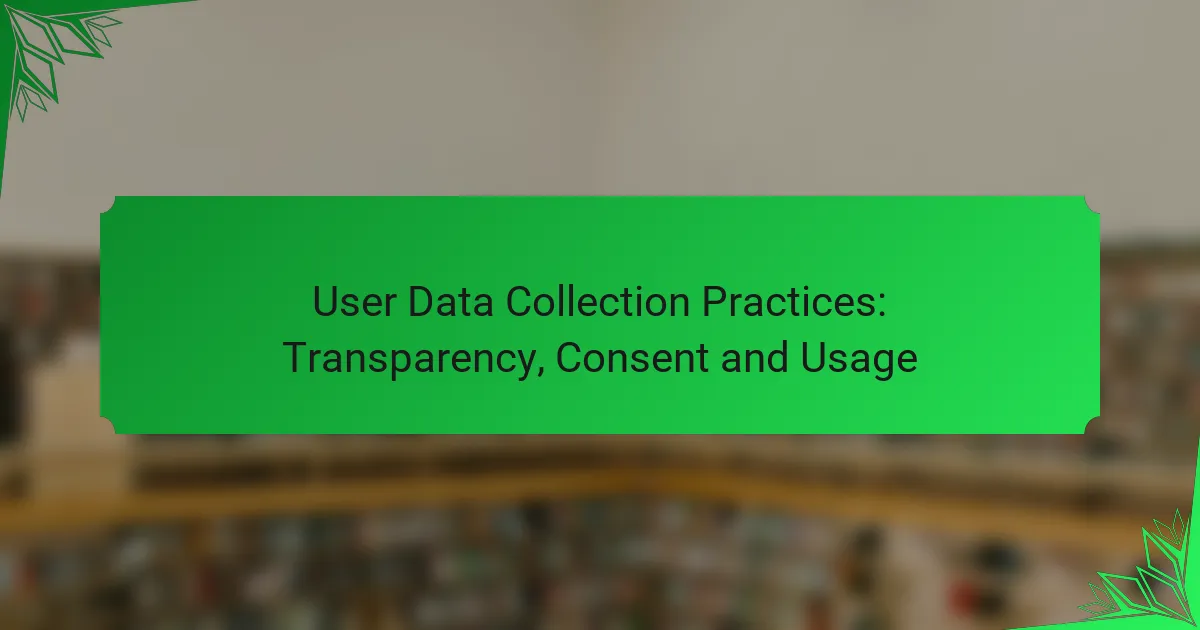User data collection practices are essential for fostering trust and protecting privacy in today’s digital landscape. By prioritizing transparency, obtaining informed consent, and ensuring responsible usage, organizations can effectively manage user information while respecting individual rights. Clear communication about data practices empowers users to make informed choices regarding their personal data.

What Are Effective User Data Collection Practices?
Effective user data collection practices prioritize transparency, consent, and responsible usage of data. These practices ensure that organizations gather only the necessary information, use it for specific purposes, and protect user privacy throughout the data lifecycle.
Data minimization
Data minimization involves collecting only the information that is essential for a specific purpose. This practice reduces the risk of data breaches and enhances user trust. For example, if a service only requires an email address for account creation, it should not request additional personal details unless absolutely necessary.
To implement data minimization, organizations should regularly review their data collection processes and eliminate any unnecessary fields in forms. This not only simplifies user experience but also aligns with privacy regulations like the GDPR, which emphasizes the importance of limiting data collection.
Purpose limitation
Purpose limitation means that organizations should clearly define and communicate the specific reasons for collecting user data. Data should only be used for the purposes stated at the time of collection, preventing misuse or unauthorized access. For instance, if data is collected for improving service quality, it should not be used for unrelated marketing without user consent.
To adhere to purpose limitation, companies should establish clear policies and inform users about how their data will be used. This transparency helps build trust and ensures compliance with legal frameworks that protect user rights.
Regular audits
Regular audits of data collection practices help organizations assess compliance with privacy policies and regulations. These audits should evaluate how data is collected, stored, and used, identifying any gaps or areas for improvement. For example, an organization might discover that certain data is being retained longer than necessary.
Conducting audits at least annually can help organizations stay accountable and ensure that their data practices align with user expectations and legal requirements. It is also beneficial to involve third-party experts for an unbiased review of data practices.
Secure storage
Secure storage of user data is critical to protect against unauthorized access and breaches. Organizations should implement strong encryption methods and access controls to safeguard sensitive information. For instance, using encryption for data at rest and in transit can significantly reduce the risk of exposure.
Additionally, companies should regularly update their security protocols and conduct vulnerability assessments. Ensuring that all employees are trained in data security best practices can further enhance the protection of user data.
Data anonymization
Data anonymization involves removing personally identifiable information from datasets, making it impossible to trace data back to individual users. This practice allows organizations to analyze trends without compromising user privacy. For example, aggregating user data to generate insights about service usage can be done without retaining individual identifiers.
Implementing data anonymization techniques can help organizations comply with privacy regulations while still deriving valuable insights from user data. However, it is essential to regularly assess the effectiveness of anonymization methods to ensure that data cannot be re-identified.

How to Ensure Transparency in Data Collection?
Ensuring transparency in data collection involves clearly communicating how user data is gathered, used, and protected. This builds trust and helps users make informed decisions about their personal information.
Clear privacy policies
Clear privacy policies are essential for transparency in data collection. These documents should outline what data is collected, how it will be used, and who it may be shared with. Use straightforward language and avoid legal jargon to make the policies accessible to all users.
Consider including examples of data types, such as personal identification information, usage statistics, or location data. Regularly review and update these policies to reflect any changes in practices or regulations.
User-friendly consent forms
User-friendly consent forms are critical for obtaining informed consent from users. These forms should be concise, clearly stating what data will be collected and the purpose behind it. Avoid overwhelming users with lengthy forms; instead, use simple checkboxes or toggle switches for consent options.
Provide users with the ability to opt-in or opt-out easily, and ensure that they can withdraw consent at any time. This empowers users and enhances their trust in your data collection practices.
Regular updates on practices
Regular updates on data collection practices keep users informed and engaged. Notify users about any significant changes to your data policies or practices through email alerts or notifications on your website. This demonstrates a commitment to transparency and user rights.
Consider establishing a routine schedule for these updates, such as quarterly or biannually, to maintain consistency. Encourage feedback from users to improve your practices and address any concerns they may have regarding their data.

What Are the Key Consent Requirements?
The key consent requirements for user data collection focus on ensuring that individuals are fully aware of and agree to how their data will be used. These requirements emphasize transparency, the need for explicit agreement, and the option for users to control the specifics of their consent.
Informed consent
Informed consent means that users must be provided with clear and comprehensive information about what data is being collected, how it will be used, and any potential risks involved. This information should be presented in an understandable manner, allowing users to make educated decisions regarding their data.
For example, a website collecting personal information should explain why the data is needed and how it will benefit the user. Providing this context helps build trust and ensures compliance with regulations like GDPR in Europe.
Explicit consent
Explicit consent requires users to actively agree to data collection practices, often through a clear affirmative action such as checking a box or clicking a button. This type of consent cannot be implied or assumed and must be documented to ensure accountability.
For instance, when a mobile app requests access to location data, it should prompt the user with a specific request that outlines the purpose of the access, ensuring that users understand what they are consenting to.
Granular consent options
Granular consent options allow users to provide consent for specific types of data collection rather than a blanket agreement. This means users can choose which data they are comfortable sharing, such as opting in for marketing communications while declining to share location data.
Implementing granular consent can enhance user experience and satisfaction, as it empowers individuals to control their data privacy. Providing clear toggles or checkboxes for different data categories can help facilitate this process.

How to Implement User Data Usage Guidelines?
Implementing user data usage guidelines involves establishing clear protocols for how data is collected, accessed, and utilized. Key components include limiting data usage, controlling access, and training employees on best practices.
Usage limitation
Usage limitation refers to the practice of restricting data collection and usage to what is necessary for specific purposes. Organizations should define clear objectives for data use, ensuring that only relevant information is gathered and retained.
For example, if a company collects user data for marketing purposes, it should avoid gathering unrelated personal information. Regular audits can help ensure compliance with these limitations and prevent unnecessary data accumulation.
Data access controls
Data access controls are essential for protecting user information from unauthorized access. Implementing role-based access ensures that only employees who need specific data to perform their job functions can access it.
Consider using multi-factor authentication and regular access reviews to enhance security. For instance, sensitive data should be accessible only to senior management or specific departments, reducing the risk of data breaches.
Employee training programs
Employee training programs are crucial for fostering a culture of data privacy and security within an organization. Training should cover the importance of data protection, compliance with regulations, and the specific guidelines for handling user data.
Regular workshops and updates can keep staff informed about evolving best practices and potential threats. For example, a quarterly training session can reinforce the importance of adhering to data usage guidelines and highlight recent changes in regulations or technology.

What Are the Risks of Non-Compliance?
Non-compliance with user data collection practices can lead to significant risks, including legal repercussions and damage to a company’s reputation. Organizations must prioritize transparency and consent to mitigate these risks effectively.
Legal penalties
Failing to comply with data protection regulations can result in severe legal penalties. For instance, companies may face fines that can reach millions of dollars, depending on the severity of the violation and the jurisdiction.
Regulations like the General Data Protection Regulation (GDPR) in Europe impose strict guidelines on data handling, and non-compliance can lead to fines of up to 4% of annual global revenue. Organizations should regularly review their data practices to ensure they meet legal standards.
Reputation damage
Non-compliance can severely damage a company’s reputation, leading to loss of customer trust. When users feel their data is mishandled, they are likely to share their negative experiences, which can deter potential customers.
Moreover, companies may face public backlash and negative media coverage, further harming their brand image. To protect their reputation, businesses should prioritize transparent data practices and actively communicate their commitment to user privacy.
